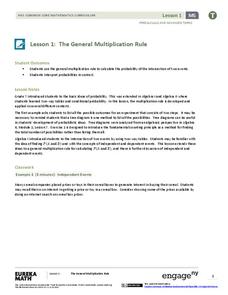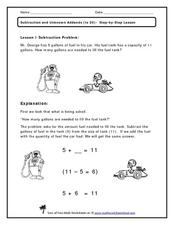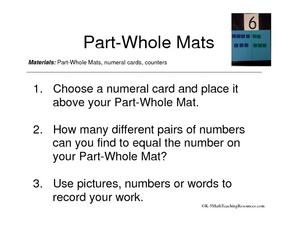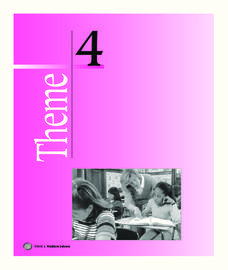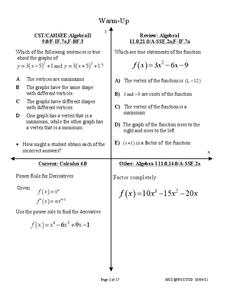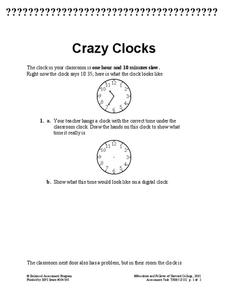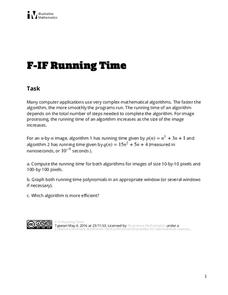EngageNY
A Focus on Square Roots
Pupils learn to solve square root equations and rationalize denominators. Problems include those with extraneous solutions.
Willow Tree
Order of Operations
It's the classic please excuse my dear aunt sally strategy to remembering the order of operations. Young mathematicians practice to develop an understanding of the order of operations. Examples and practice problems include...
EngageNY
Solving a Linear Equation
Solving an equation is the art of creating simpler equivalent equations using properties of equality. Here, classes see that solving an equation is not always as easy as guessing. The lesson presents linear equations that scholars must...
EngageNY
The General Multiplication Rule
In the first installment of a 21-part module, scholars build on previous understandings of probability to develop the multiplication rule for independent and dependent events. They use the rule to solve contextual problems.
Curated OER
Storing CD's
Students will solve a word problem as an in depth investigation,. The lesson plan is based upon standards that are foundational to further development of math skills. The learners use logic and higher order thinking skills to accomplish...
Curated OER
How Many Cans of Juice?
Use something familiar to students in this word problem; juice! They examine a scenario in which two summer campers each bring a certain number of juice cans to camp, finding the total number of cans they have together. Pictures give...
Curated OER
Ratio Problems Worksheet 3
In this ratios worksheet, students solve word problems containing ratios of pencils, hot dogs, and more. Students complete 5 problems.
Curated OER
Place Value and Expanded Form
Because there is only one place-value problem here and a detailed explanation below, use this as an all-class warm up. Learners write 369 in expanded form with a little assistance by a place value table. They can fill in the hundreds,...
Curated OER
Problem Solving
This problem-solving PowerPoint includes detailed steps to follow when solving a math story problem. Each slide describes and gives an example of what a student should ask himself and/or what particular strategy would work in order to...
Curated OER
Focus on Problem Solving: Choose a Method 20.5
For this focusing on word problem solving worksheet, students read the word problem, rewrite the question, explain their choice of method to solve, and solve the problem with an explanation of the solution. Students solve two problems...
Curated OER
Problem Solving: Use a Bar Graph
In this using a bar graph to solve a word problem activity, students refer to the U.S. Radio Station Formats bar graph to write the steps needed to solve and explain how the bar graph helped solve the problem. Students write four short...
Curated OER
Solve for the Unknown
In this unknown worksheet, students solve simple one-step algebraic inequalities. This two-page worksheet contains 6 simple problems. Answers are provided on the last page.
Curated OER
Modeling Two Step Equations
Students study linear equations. Using algebra tiles, they model solving two-step linear equations. They discuss inverse operations, demonstrate solutions and justify answers. Given worksheets, students solve real world problems.
Curated OER
Subtraction and Unknown Addends (to 20)
How many more gallons of fuel does Mr. George need to fill his car to capacity? This word problem uses the unknown addend strategy to get scholars subtracting and thinking about the relationship between mathematical...
Curated OER
Part-Whole Mats
A part-whole mat is a great way to practice simple addition using math manipulatives. Learners choose a number card and place it at the top of their mat. Using counters, they record the different number pairs which would add together to...
Houghton Mifflin Harcourt
Problem Solvers: English Language Development Lessons (Theme 4)
How can you teach a text to a group of readers who struggling with the language? The second in a set of three ESL lessons related to Theme 4: Problem Solvers engages English language learners by introducing vocabulary and grammar...
National External Diploma Program Council
Finding an Average
Young hopefuls can practice finding the average of a group of numbers represented in tables and word problems.
West Contra Costa Unified School District
Particle Motion
Derivatives are useful for many things — they can even keep track of particle motion. An informative lesson plan provides an introduction to the idea of the second derivative in particle motion. Class members determine the...
Concord Consortium
Crazy Clocks
While a stopped clock is right twice a day, a fast or slow clock confuses people for weeks. Scholars observe a clock running slow and must correct it before observing a clock running fast and working it backward. Finally, a multi-step...
Novelinks
Words by Heart: Guided Imagery
Sad, depressed, miserable, inconsolable, forlorn: so many synonyms have a lot of variety with their connotations. Through the guided imagery activity, writers explore the use of connotation and its influence on imagery and description by...
Reading Worksheets
Inferences Worksheet 9
Help your pupils take charge of their inferring abilities with an exercise designed for direct practice with making and supporting inferences. Learners read four short passages and answer two to three questions for each passage that...
Illustrative Mathematics
Running Time
Ever wonder why that computer image takes so long to load? Well, math is involved and provides the algorithms needed to compute the measure in nanoseconds. Young mathematicians plug the image measures into the formulas and compare the...
EngageNY
End-of-Module Assessment Task: Grade 6 Math Module 4
Finish out the module with a bang. The last installment of a 36-part module is an end-of-module assessment task. Test takers set up equations to represent relationships and solve problems in an assortment of contexts.
CK-12 Foundation
Properties of Multiplication in Decimal Operations: Balloon Animals
Commutive and associative properties are the focus of a five-question interactive. Dealing with decimal multiplication and addition, mathematicians solve multiple-choice and true or false questions using a model that moves balloons along...





